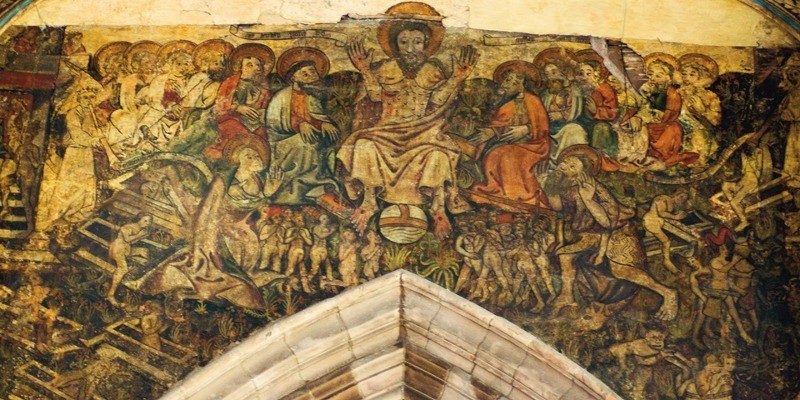Historian and CovSoc member, Peter James, tells us about the Doom Painting and the Mystery Play that accompanied it. Peter writes……

Around 1430 a Doom or Apocalypse Painting was completed in Holy Trinity Church above the tower arch. It was meant to show the consequences of good and evil acts with Christ sitting in judgement.
There had been an earthquake in Coventry around that time which possibly raised fears of the Day of Judgement being imminent. During the reign of Elizabeth I some hundred years or so later the image was covered in whitewash.
In 1831 David Gee restored the painting by removing the whitewash and covering it in varnish to protect it. Bitumen in the varnish caused the paint to darken so once again the painting almost disappeared. Around 1995 it was rediscovered and views were sought on how best to clean the painting and then preserve it. Work commenced in 2002 and continued for two years until the restoration was completed.
Finally on 11th September 2004 the medieval mural was unveiled. Its historical importance as a piece of medieval art lies in its age, as it was completed 50 to 60 years before The Last Supper mural by Leonardo da Vinci.
Doomsday Play
The first reference to the Doomsday Play seen at the Corpus Christi festival is in 1457. A Leet Book entry mentions it being performed by the Drapers Guild. ” Pageants or Dramatic Mysteries Anciently Performed at Coventry ” by Thomas Sharp mentions the script being updated in 1519. There was a further revision during the Reign of Queen Mary between 1553 and 1559. Sadly no copies of any version of the script have survived. The play appears to have been recognised nationally as well as locally even being seen by royalty.
There was a Drapers Chapel in St. Michaels Church and Mary Dormer Harris a local historian mentioned that one of the misericords featured the Doomsday subject. Unfortunately the misericord was destroyed during the Blitz in November 1940. Accounts for the Coventry Drapers Company from the mid 16th century provide evidence of the production costs including payments to artists and for 3 rehearsals. In addition to scenery, devices were needed to provide special effects. One example is an “Earthquake” first introduced in 1556 achieved by using a barrel. Other accounts from that year show that an actual fire using smoke and flames had been introduced.

The accounts for 1561 to 1573 give an itemised list of all expenditure involved with the performance. The accounts for 1561 list all of the characters namely God, two devils, three white souls, three black souls, four angels, two worms of conscience and three patriarchs. Additionally music by singing men, a trumpeter plus a musician to play the Regals (a reed organ). A technical crew responsible for a windlass and Hell’s mouth. Expenses for three rehearsals and one associated supper were included. Collection and preparation of the pageant wagon was also mentioned along with the blacking out of the soul’s faces. Finally 3s- 8d for three model worlds made by Robert Croo.
The Leet Book entry for 1457 describes a royal visit. Queen Margaret wife of King Henry VI viewed the series of pageants from a house in Earl Street. She witnessed the earlier plays in the cycle but not the Doomsday Play. This is how it was recorded :-
“She sygh (saw) then alle the Pagentes playde save Domes-day which might not be playde for lak of day”
